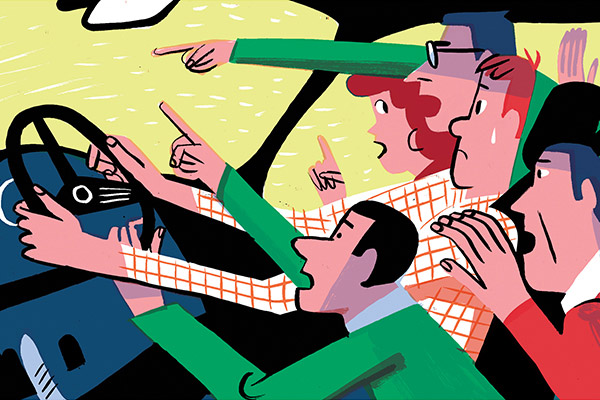Whether it was Mom who said you can’t get a ticket for driving too slowly, or an older sibling who insisted you can make a right turn on red anywhere, you’ve probably gotten some erroneous driving advice over the years. Tips that are well-intentioned, but simply untrue or outdated since you first took to the road in…er, never mind the year. The point is to avoid traffic tickets and accidents. To do that, you need to know the truth about those long-held family driving traditions. We separated the good advice from the bad below.
“My mom told me to put my hands on the wheel at the 10 and 2 positions on the clock, but I’m more of a one-handed, 12 o’clock type of driver,” says Jennifer M. of New York, N.Y.
The Truth: Before power steering, you had to place your hands higher on the wheel to control the car. Hence, the famous 10 and 2 advice. But driving experts now suggest holding on at the 9 and 3 o’clock positions. “Positioning your hands at 9 and 3 allows the driver greater range of motion, and the ability to make potentially-lifesaving evasive maneuvers without ever having to take your hands off the wheel,” says Doug Herbert, multi-time top fuel drag racing champion and founder of the non-profit B.R.A.K.E.S Teen Pro-Active Driving School. You should also think about how far you are away from the steering column. “A driver’s arms should never be resting against an airbag, because the forces of a deploying airbag or the gases exhausted by an airbag can cause injury,” says Russ Rader, senior vice president of communications at the Insurance Institute for Highway Safety (IIHS). Sit with your chest positioned at least 10 inches from the wheel for safety, says Rader.
The Myth: Use The “Mom Arm”
“My mom had to unlearn throwing her arm across the passenger seat when she slammed on the brakes,” says Colleen S. of Newburgh, Ind. “She said it was a tough habit to break. But I never got hurt!”
The Truth: In the pre-seat belt era, the instinct to protect your passenger found its outlet in the “mom arm” maneuver. Unfortunately, that move might only serve to injure the driver’s arm or the passenger’s face. Instead, “everyone in the car should be buckled up,” says Rader. Seatbelts save thousands of lives every year, according to the IIHS.
The Myth: There Are Times You Can Ignore Signs
The Truth: That is absolutely never OK! Driving the wrong way on a one-way street can lead to a ticket and, worse, a head-on collision. “And if you’re lost or confused about where to turn to follow your GPS directions, pull safely to the side of the road to figure it out, rather than risk the consequences of a hasty decision or distraction while underway,” says Herbert. According to the NHTSA, distracted driving is anytime your hands are off the wheel, your eyes aren’t on the road, or you stop thinking about what you’re doing. So pull over safely if you’re lost or need directions.
The Myth: Speed Wisely
“My mom taught me that you’re safe from a ticket if you drive less than 10mph over the limit. Haven’t gotten one yet!” says Kate M. from Ithaca, N.Y.
The Truth: Anytime you’re driving over the speed limit, you risk getting a ticket. The speed limit posted is there to protect you, other motorists and pedestrians. And when the law is enforced, drivers slow down, which in turn saves lives, according to the IIHS. Remember, too, that fines and penalties may be higher in work zones and school zones.
The Myth: Always Be Prepared
“My dad taught me to keep a bucket of sand in the trunk in winter. When most cars had rear wheel drive, the extra weight in the back of the car gave you better traction in snow. Plus, you could put the sand under the tires [for traction]—using the shovel that, of course, you also kept in the car,” says Eric T. of Portland, Maine.
The Truth: Carrying a well-stocked emergency kit is essential, but these days the most important item in it isn’t a shovel; it’s your cell phone. “If you have roadside assistance, give them a call and let the experts help you out!” says Herbert.
Now that you know the best driving advice, get out on the road—for less! Get a free quote from GEICO today and you see how much you could save on car insurance.
By Julie Russell
